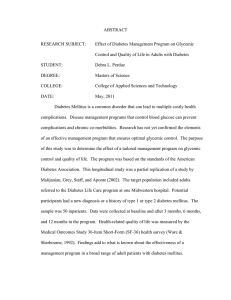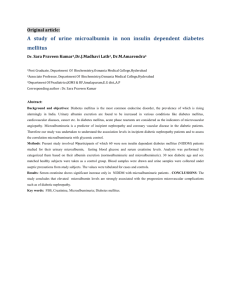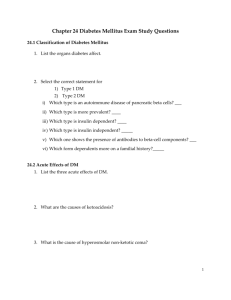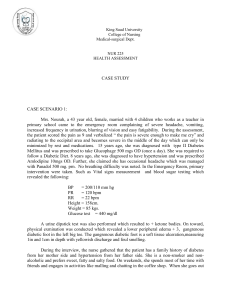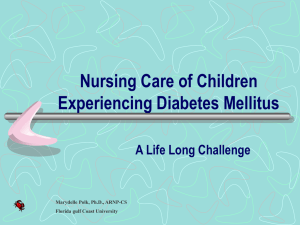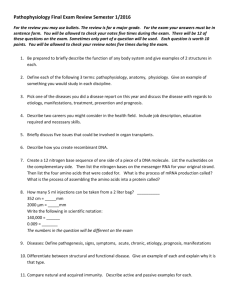Document 14240072
advertisement
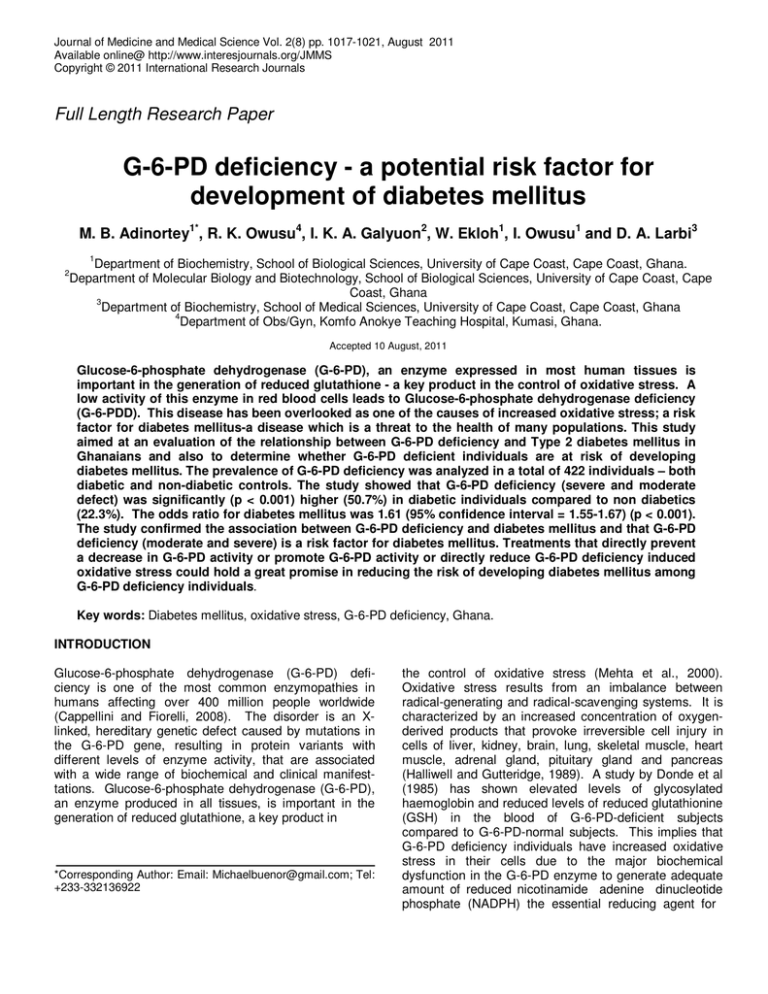
Journal of Medicine and Medical Science Vol. 2(8) pp. 1017-1021, August 2011 Available online@ http://www.interesjournals.org/JMMS Copyright © 2011 International Research Journals Full Length Research Paper G-6-PD deficiency - a potential risk factor for development of diabetes mellitus M. B. Adinortey1*, R. K. Owusu4, I. K. A. Galyuon2, W. Ekloh1, I. Owusu1 and D. A. Larbi3 1 Department of Biochemistry, School of Biological Sciences, University of Cape Coast, Cape Coast, Ghana. Department of Molecular Biology and Biotechnology, School of Biological Sciences, University of Cape Coast, Cape Coast, Ghana 3 Department of Biochemistry, School of Medical Sciences, University of Cape Coast, Cape Coast, Ghana 4 Department of Obs/Gyn, Komfo Anokye Teaching Hospital, Kumasi, Ghana. 2 Accepted 10 August, 2011 Glucose-6-phosphate dehydrogenase (G-6-PD), an enzyme expressed in most human tissues is important in the generation of reduced glutathione - a key product in the control of oxidative stress. A low activity of this enzyme in red blood cells leads to Glucose-6-phosphate dehydrogenase deficiency (G-6-PDD). This disease has been overlooked as one of the causes of increased oxidative stress; a risk factor for diabetes mellitus-a disease which is a threat to the health of many populations. This study aimed at an evaluation of the relationship between G-6-PD deficiency and Type 2 diabetes mellitus in Ghanaians and also to determine whether G-6-PD deficient individuals are at risk of developing diabetes mellitus. The prevalence of G-6-PD deficiency was analyzed in a total of 422 individuals – both diabetic and non-diabetic controls. The study showed that G-6-PD deficiency (severe and moderate defect) was significantly (p < 0.001) higher (50.7%) in diabetic individuals compared to non diabetics (22.3%). The odds ratio for diabetes mellitus was 1.61 (95% confidence interval = 1.55-1.67) (p < 0.001). The study confirmed the association between G-6-PD deficiency and diabetes mellitus and that G-6-PD deficiency (moderate and severe) is a risk factor for diabetes mellitus. Treatments that directly prevent a decrease in G-6-PD activity or promote G-6-PD activity or directly reduce G-6-PD deficiency induced oxidative stress could hold a great promise in reducing the risk of developing diabetes mellitus among G-6-PD deficiency individuals. Key words: Diabetes mellitus, oxidative stress, G-6-PD deficiency, Ghana. INTRODUCTION Glucose-6-phosphate dehydrogenase (G-6-PD) deficiency is one of the most common enzymopathies in humans affecting over 400 million people worldwide (Cappellini and Fiorelli, 2008). The disorder is an Xlinked, hereditary genetic defect caused by mutations in the G-6-PD gene, resulting in protein variants with different levels of enzyme activity, that are associated with a wide range of biochemical and clinical manifesttations. Glucose-6-phosphate dehydrogenase (G-6-PD), an enzyme produced in all tissues, is important in the generation of reduced glutathione, a key product in *Corresponding Author: Email: Michaelbuenor@gmail.com; Tel: +233-332136922 the control of oxidative stress (Mehta et al., 2000). Oxidative stress results from an imbalance between radical-generating and radical-scavenging systems. It is characterized by an increased concentration of oxygenderived products that provoke irreversible cell injury in cells of liver, kidney, brain, lung, skeletal muscle, heart muscle, adrenal gland, pituitary gland and pancreas (Halliwell and Gutteridge, 1989). A study by Donde et al (1985) has shown elevated levels of glycosylated haemoglobin and reduced levels of reduced glutathionine (GSH) in the blood of G-6-PD-deficient subjects compared to G-6-PD-normal subjects. This implies that G-6-PD deficiency individuals have increased oxidative stress in their cells due to the major biochemical dysfunction in the G-6-PD enzyme to generate adequate amount of reduced nicotinamide adenine dinucleotide phosphate (NADPH) the essential reducing agent for J. Med. Med. Sci. 1018 oxidized glutathionine (GSSH) needed for the protection of cells against free radical oxidative attack. Oxidative stress, which is a characteristic of G-6-PD deficient individuals (Beutler, 1994) is reported to predispose normal individuals to diabetes mellitus (Moussa, 2008). It is suggested as one of the factors that plays a major role in the pathogenesis of diabetes mellitus. According to a study by Chanmugam and Frumin (1964) glucose tolerance is altered in subjects with G-6-PD deficiency. Another study by Illing et al (1951) also reported that the level of reduced glutathione in blood of diabetics is decreased. These studies suggest that G-6-PD deficient individuals may be more prone to diabetes mellitus compared to non-G-6-PD deficiency individuals. Based on this, it can be hypothesized that there is an association between G-6-PD deficiency and diabetes mellitus among Ghanaians and that G-6-PDD is a risk factor for developing diabetes mellitus. G-6-PD deficiency has been overlooked as a cause of increased oxidative stress which has led to little research work on the influence of G-6-PD deficiency in the prevalence and development of diabetes mellitus. In view of this, the aim of this study was to evaluate the association of G-6-PD deficiency and diabetes mellitus in Ghana. MATERIALS AND METHODS Study area The study was carried out at the Central Regional Hospital located in Cape Coast in the Central Region of Ghana. The presence of diabetes mellitus was assessed in all study participants. Participants were divided into type 2 diabetics and non-diabetics (control) according to the criteria laid down by the World Health Organization (WHO, 2006). The work was carried out at the Central Regional Hospital Reference Laboratory within the period December 2009- May 2010. Biodata, including age, sex, and body mass index (BMI), were collected using a specially constructed questionnaire. Subjects All participants consented to participate in the research. Study protocols were approved by the ethics committee of the Central Regional Hospital, Cape Coast, Ghana. Participants were selected by strict random sampling after providing written or thumb printed informed consent. The sample size was calculated using a G-6-PD deficinecy prevalence rate of 15 - 25% in Ghana (WHO, 1989). Participants were all given a full physical examination by a physician at the Central Regional Hospital. A total of 422 subjects were enrolled into the study with equal proportions for both diabetics and non-diabetics. All the diabetics were already diagnosed type 2 diabetics on hypoglycaemic drugs and / or diet. Patients who had diabetes mellitus attending the Diabetic Clinic of the Central Regional Hospital and healthy non diabetic controls from the Cape Coast metropolis of Ghana were recruited into the study. The volunteers were explained the significance of the study and after been convinced gave their consent to participate in the study. Exclusion criteria Sickle cell anaemia and other serious recognized acute complications were used as an exclusion criteria for both diabetics and non diabetic. Patients suffering from sickle cell anaemia/trait were excluded from this study because research has shown that sickle cell trait has also been suggested to be associated with oxidative stress and insulin resistance (Alsultan et al., 2010). Inclusion criteria All diabetic included in the study were diagnosed based on a criteria laid down by WHO (FBG ≥ 7.0 mmol/L) and were attending the diabetic clinic already. All subjects diagnosed as non diabetics were defined by WHO criteria (FBG≤ 6.7 mmol/L) (WHO, 2006). The controls were normal individuals without diabetes mellitus who were accompanying patients to clinic with other unrelated conditions such as typhoid fever, stomach ulcers, fever, etc. FBG, G-6-PDD and Sickle Cell Assay Fasting venous blood (10 mL) sample was collected from the arm of each participant separated into two tubes containing fluoride and acid-citrate-dextrose (ACD) after which, fasting blood glucose (FBG) was determined according to the principle of enzymatic oxidation in the presence of glucose oxidase (Barham and Trinder, 1972) using an automated chemistry analyzer (ATAC 8000 Random Access Chemistry system). Brewer qualitative methaemoglobin (MetHb) reduction test (Brewer et al., 1960) was employed in determining G-6-PDD status (moderate defect, severe defect and non-deficient or normal). The sodium metabisulphite reduction test was used to determine the sickle cell status of participants (Rusia and Sood, 1988). This is a test for sickle-cell haemoglobin in which red blood cells are deoxygenated by the addition of sodium metabisulphite and the cells Adinortey et al. 1019 Table 1: General characteristics of the study population Parameters N Type 2 diabetes 211 Control 211 P-value Age (years) Median (range) 54 (30-81) 32 (17-75) <0.001 Mean BMI (Kg/ m2) FBG (mmol/ L) 54.42±0.92 27.42±0.32 9.12±0.25 52±1.39 25.32±0.22 4.78±0.07 >0.05 <0.001 <0.001 All Data presented as mean ± standard error of mean except median Table 2: Prevalence of G6PD Status of diabetics and non diabetic controls G-6-PD status G-6-PD Severely Defective G-6-PD Moderately Defective G-6-PD Non Defective Diabetes mellitus N=211 74 (35.1%) 33 (15.6%) 104 (49.3%) Control N=211 27 (12.8%) 20 (9.5%) 164(77.7%) P-value <0.001 <0.05 <0.001 Data presented as counts and percentage count containing the defective haemoglobin assume a sickle shape. RESULTS Characteristics of the study population Body Mass Index measurements Participants were weighed in light clothing without shoes and their heights were measured with a stadiometer. Body Mass Index (BMI) was calculated as kilogram per metre square that is body mass / height2. Statistical analysis All data were saved in a common database and statistically analyzed using SPSS version 16.0 software (SPSS Inc., Chicago, IL, USA). Cross tabulations were used to analyse the data and association was tested using Pearson Chi-square at 5% level of significance. The statistical difference between cases and the controls for age, BMI and FBG was tested at 5% level of significance using the independent t- test after a normality test showed skewness and Kurtosis to be between (-2 and +2) . Multiple regression analysis was also conducted at the same level of significance to determine G-6-PDD patients’ relative risk of developing diabetes mellitus keeping age and BMI constant since age and BMI have been reported to have an effect on the development of diabetes mellitus. The median age of all participants was 43 years, ranging from 17 to 81years. Data not shown. The median ages of non- diabetics and diabetics was 54 and 32 years respectively (Table 1). The mean age of non- diabetics (52±1.39 years) was not significantly different (P >0.05) from that for patients with diabetes (54.42±0.92 years). The diabetics had a significantly (p< 0.001) higher BMI than the control group. The FBG levels for diabetics was also significantly higher p<0.001) compared to nondiabetic control. Prevalence of G-6-PDD status of diabetics and nondiabetics Amongst the 211 type 2 patients studied, there was a significantly (p< 0.001) higher prevalence of G-6-PD severely defective (35.1%) compared to 12.8% in nondiabetes individuals. A significantly (p< 0.001) higher percentage of G-6-PD non-defective (77.7%) was recorded for the control compared to 49.3% in the diabetic group. For the moderate defect, 15.6% was observed for diabetes mellitus patients, whereas 9.5% was recorded for the control group (Table 2). J. Med. Med. Sci. 1020 Risk of developing Type 2 diabetes mellitus G-6-PD deficiency patients (low G-6-PD activity) relative risk of having type 2 diabetes mellitus was 1.61 times higher than that for non-defective G-6-PD deficiency patients in the study group with a confidence interval (1.55-1.67) (p <0.001). DISCUSSION Diabetes mellitus is a multi-factorial disease in which increased oxidative stress plays an important pathogenic role (Moussa, 2008). Glucose-6-phosphate dehydrogenase (G-6-PD) deficiency has been considered to play a role in increased oxidative stress - a known risk factor for diabetes mellitus. Diabetes mellitus is a well known threat to the health of many populations. In this study, fasting blood glucose (FBG) was used as primary inclusion criteria for both groups. The higher body mass index (BMI) recorded for diabetic patients is consistent with earlier BMI findings for Ghanaian diabetics (Nyarko et al., 1997) and confirms the observation that higher BMI is a major risk factor for the development of diabetes mellitus (Kmuiman et al., 1986). Several studies have reported different levels of association between diabetes and G-6-PD deficiency in various populations (Eppes et al., 1969; Billis et al., 1970; Saha, 1979; Saeed et al., 1985; Nazi, 1991; Meloni et al., 1992), which have generated several research interests in the pathogenic role of G-6-PD deficiency in diabetes mellitus among Ghanaians. The higher prevalence of G-6-PD deficiency observed in diabetics than in the non-diabetics in this study is consistent with other reports that there is a positive association between G-6-PD deficiency and diabetes mellitus (IIIing et al., 1951; Saha, 1979). Moreover G-6PD deficiency patients were at a higher risk of developing type 2 diabetes than G-6-PD deficiency normal patients, which is also in agreement to what has been reported elsewhere (Gaskin et al 2001; Wan et al., 2002). Several reasons have been attributed to the susceptibility of G-6-PD deficiency patients to diabetes mellitus. The pentose phosphate pathway in G-6-PD deficiency patients is unable to generate enough NADPH to reduce the oxidized glutathione (Mehta et al., 2000) leading to altered glucose tolerance in subjects with G-6PD deficiency. Thus the decrease in levels of reduced glutathione leads to increased oxidative stress - a risk factor in diabetes. Hence G-6-PD deficient individuals are likely to become diabetic. Also according to Grankvist et al (1981), Malaisse et al (1982), Robertson (2004), β-cells in islets of langerhans of pancreas are highly sensitive to increased reactive oxygen species (ROS) thus can easily be destroyed by increased free radicals as seen in G-6-PD deficinecy status. Comparative studies of gene expression of superoxide dismutase (SOD), catalase, and glutathione peroxidase in various mouse tissues (liver, kidney, brain, lung, skeletal muscle, heart muscle, adrenal gland and pituitary gland), with pancreatic islets showed substantially lower gene expression in pancreatic islets (Lenzen, 1996; Tiedge et al., 1997). These findings could explain why G-6-PD deficiency patients are more susceptible to developing diabetes mellitus and other oxidative stress-related diseases such as cancer. According to a study by Zhang et al (2010), an increase in the activity of G-6-PD rescues β cells from cell death, confirming the role of G-6-PD in the pathogenesis of type 2 diabetes mellitus as observed in this study. Limitations of the study A possible limitation is that the study was not conducted in the way to prove causality thus G-6-PD cannot be said to cause diabetes mellitus but rather a risk factor for the development of diabetes. Also measuring certain oxidative stress indicators could confirm the oxidative stress status of G-6–PD deficiency patients. The controls in the study were relatively much younger than cases. Moreover the use of a more sensitive molecular biology tools than just qualitative test may confirm more G-6-PD deficiency positives than was observed in the study. There are many factors that affect diabetes mellitus development so it is impossible to make definitive conclusions about oxidative stress consequence relation between G-6-PD activity and diabetes mellitus thus further studies on larger study groups with several variables are needed to address those issues. CONCLUSION The results of this study suggest that G-6-PD deficiency may be a risk factor for diabetes mellitus. It remains to be determined in some future studies whether treating G6-PDD patients could reduce the risk of developing diabetes mellitus and whether G-6-PD screening could help in identifying patients at increased risk of developing type 2 diabetes mellitus which could benefit from prevention. REFERENCES Alsultan AI, Seif MA, Amin TT, Naboli M, Alsuliman AM (2010). Relationship between oxidative stress, ferritin and insulin resistance in sickle cell disease. Eur. Rev. Med. Pharmacol. Sci. 14: 527-538 Barham D, Trinder P (1972). An improved colour reagent for the determination of blood glucose by oxidase system. Analyst. 97:142145. Adinortey et al. 1021 Beutler E (1994). G6PD deficiency. Blood. 84:3613-3636. Billis AG, Xefteris ED, Ioannides PJ, Papastamatis SC (1970). Abnormal glucose tolerance in favism. Diabetol. 6:425–429 Brewer GJ, Tarlov AR, Alving AS (1960). Methaemoglobin reduction test: a new, simple, in vitro test for identifying primaquine-sensitivity. WHO Bull. 22: 633-640 Cappellini MD, Fiorelli G (2008). Glucose-6-phosphate dehydrogenase deficiency. Lancet. 371: 64–74. Chanmugam D, Frumin AM (1964). Abnormal glucose tolerance response in erythrocyte glucose-6-phosphate dehydrogenase deficiency. New England J. Med. 271: 1202-1204. Donde UM, Baxi AJ, Tawil HE, Kilani G (1985). Glycosylated hemoglobin in glucose-6-phosphate dehydrogenase deficiency. Lancet. pp 47 Eppes RB, Lawrence AM, McNamara JV, Powell RD, Carson PE (1969). Intravenous glucose tolerance in negro men deficient in glucose-6-phosphate dehydrogenase. N. Engl. J. Med. 281:60–63 Gaskin RS, Estwick D, Pedi R (2001). G6PD deficiency: its role in the high prevalence of diabetes mellitus. Ethnicity and Disease.11: 749754. Grankvist K, Marklund SL, Täljedal IB (1981). CuZn-superoxide dismutase, Mn-superoxide dismutase, catalase and glutathione peroxidase in pancreatic islets and other tissues in the mouse. Biochem. J. 199:393–398, Halliwell B, Gutteridge JMC (1989). Free Radicals in Biology and nd Medicine, 2 ed., Clarendon Press, Oxford,. Illing EKB, Gray CH, Lawrence RD (1951). Blood glutathione and nonglucose substances in diabetes. Biochemical J. 48: 637-640. Knuiman MW, Welborn TA, McCann VJ, Stanton KG, Constable IJ (1986). Prevalence of diabetic complications in relation to risk factors. Diabetes.35: 1332-1339. Lenzen S, Drinkgern J, Tiedge M (1996). Low antioxidant enzyme gene expression in pancreatic islets compared with various other mouse tissues. Free Radic. Biol. Med. 20:463–466, Malaisse WJ, Malaisse-Lagae F, Sener A, Pipeleers DG (1982). Determinants of the selective toxicity of alloxan to the pancreatic B cell. Proc. Natl. Acad. Sci. U S A; 79:927–930, Mehta A, Mason PJ, Vulliamy TJ (2000). Glucose-6-phosphate dehydrogenase deficiency. BaillieÁ re's Clin. Haematol. 13: 21-38 Meloni T, Pacifico A, Forteleoni G, Meloni GF (1992). G6PD deficiency and diabetes mellitus in northern Sardinian subjects. Haematol. 77:94–95 Moussa SA (2008). oxidative stress in diabetes mellitus. Romanian J. Biophys.18: 225–236 Niazi GA (1991). Glucose-6-phosphate dehydrogenase deficiency and diabetes mellitus. Int. J. Hematol. 54:295-298 Nyarko A, Adubofour K, Ofei F, Kpodonu J, Owusu S (1997). Serum lipid and lipoprotein levels in Ghanaians with diabetes mellitus and hypertension. J. Natl. Med. Assoc . 89(3):191-196 Robertson RP (2004). Chronic oxidative stress as a central mechanism for glucose toxicity in pancreatic islet beta cells in diabetes. J. Biol. Chem. 279: 42351–42354 Rusia U, Sood SK (1988). Special Haematological Tests. In: Mukherjee, K.L, ed. Medical Laboratory Technology; a Procedure Manual for Routine Diagnostic Tests. New Delhi: Tata McGraw-Hill. p. 308-330. SaeedTK, Hamamy HA, Alwan AA (1985). Association of glucose-6phosphate dehydrogenase deficiency with diabetes mellitus. Diabetic Med. 2:110-112. Saha N (1979). Association of G6PD with diabetes mellitus in ethnic groups in Singapore. J Med. Genet.18:431-434. Tiedge M, Lortz S, Drinkgern J, Lenzen S (1997). Relation between antioxidant enzyme gene expression and antioxidative defense status of insulin-producing cells. Diabetes. 46:1733–1742, Wan GH, Tsai SC, Chiu DTY (2002). Decreased blood activity of glucose-6-phosphate dehydrogenase associates with increased risk for diabetes mellitus, Endocrine.19:191-195 WHO Working Group. Glucose-6-phosphate dehydrogenase deficiency. Bull WHO, 1989; 67:601–6011. WHO. (2006). Definition and diagnosis of diabetes mellitus and intermediate hyperglycemia: Report of a WHO / IDF Consultation, Geneva, Switzerland Zhang Z, Liew CW, Handy DE, Zhang Y, Leopold JA, Hu J, Guo L, Kulkarni RN, Loscalzo J, Stanton RC (2010). High glucose inhibits glucose-6-phosphate dehydrogenase, leading to increased oxidative stress and β-cell apoptosis. The FASEB J. 24:1497-1505

